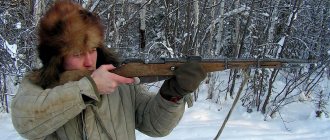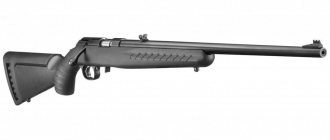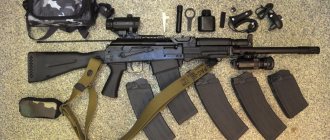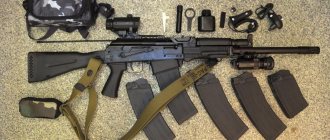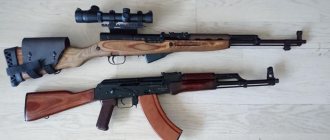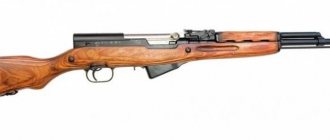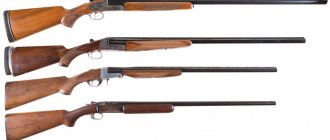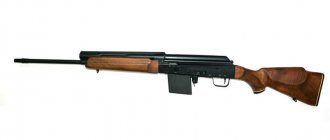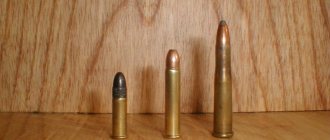- October 12, 2018
- Weapons and ammunition
- Dmitry Averkin
Those who are involved in hunting know what a tedious and long path it is necessary to go through before the first shot at a game or animal. Before you go to the store to arm yourself and purchase other necessary equipment, you need to obtain a shooting license and a permit to purchase weapons.
But that’s not so bad. A couple of decades ago, the entire range of hunting rifles fit on one counter; it was represented by only two factories: the Izhevsk Machine-Building Plant and the Tula Arms Plant, that is, IZH and TOZ products, respectively. In today's arms market the situation is completely different. Stores are simply bursting with a variety of hunting rifles and calibers of all stripes. And even experienced fishermen sometimes fall into a stupor, not to mention those who are new to this business.
You need to figure out how to choose a decent hunting rifle and not make a mistake with the purchase. Many will be interested in the critical characteristics of the weapon, which must be paid attention to. Specific models will be given as examples. The latter will be presented in the form of a small mini-rating of the best carbines for hunting, where each section has its own current list of participants.
Types of weapons
First you need to decide on the classification of hunting weapons. It can be smooth-bore or rifled. The former are used mainly for hunting small game and fur-bearing animals. Such guns fire shot or buckshot. There are also pneumatic hunting rifles, but they are considered more of a sporting option, and one cannot count on any serious fishing here.
Smoothbore weapons perform well at short distances due to their good accuracy. The hardest thing to miss is. Shotguns are most often used by beginners and amateur hunters, and less often by professionals. A striking representative of this segment is the legendary IZH (MR)-27. This category will not be considered, attention will be focused on the next, more serious one.
Photos of hunting weapons
This gallery presents photos of the most famous types and models of hunting weapons that can be purchased in Russia. In addition to the usual firearms for hunting, we present other types of weapons that have recently become quite popular, such as air rifles, bows and crossbows, as well as spearguns.
One of the first post-war hunting rifles in the USSR was the TOZ “A-3” hammerless double-barreled horizontal shotgun, 12 gauge. Developed in 1947. In 1948, only one copy was made; in 1949, 31 units were produced. Produced individually until 1952. Largely copied from Zimson-74E produced in the GDR.
This is one of the simplest in design and a very reliable hunting rifle IZH-18 designed for various types of hunting. The main purpose of the gun is fishing. It is suitable for firing smoky and smokeless powder using both metal, plastic and paper cartridges.
The legendary hammerless IZH-43 is a double-barreled shotgun with a classic horizontal barrel arrangement. A simple design, 12 or 16 gauge, 70 mm chamber length, double locking, two triggers and a weight of only 3.4 kg make this gun an excellent type of hunting weapon.
TOZ BM-16 was the most popular weapon in the USSR in the 50-60s of the last century. Simple and reliable, it was the only double-barreled shotgun available to the average person. Until 1948, they were produced with barrels made of captured Krupov steel. Maybe this is why they are not demolished; they serve conscientiously to this day.
The TOZ-34 double-barreled vertical shotgun is one of the most common smooth-bore hunting shotguns in our country. This simple design and very reliable double-barreled shotgun has been produced in 12 16, 20, 28 calibers since 1964 at the Tula Arms Plant almost without changes.
Double-barreled shotgun with vertical barrels. Caliber 12, chamber 76 mm, barrel length - 725 mm, stock - wood: walnut, beech. Weight - 3.6 kg. Price from 20,000 rub. Produced since 1973, more than 1.5 million units produced.
Multi-shot automatic shotgun IZH 12 caliber. Barrel length - 610 mm. Chamber - 12/70, 12/76 Magnum, 12/89 Super Magnum. Magazine: 12/76 - 4 rounds, 12/89 - 3 rounds. The stock is wood or plastic with a folding stock. Weight - 3.4 kg. Price from 20,000 rub. Produced since 2000.
One of the best Russian-made rifles of 9 mm caliber, chambered for 9?53 cartridge with a bullet weighing 15 g. Barrels 600 mm long, weight without optics 3.8 kg. Bullet speed at 25 meters is 650 m/sec. Dispersion at 100 meters is 8 centimeters. Manufactured individually since 1968 based on the MTs-10 model. Oddly enough, such a gun was Eric Honecker’s favorite hunting weapon, but Germany has its own cool hunting weapons. Now the modernized version is produced under the brand name MTs 110-09. The price of antique MC 10-09 is from 500 thousand rubles. Price MC 110-09 to order from 150 thousand rubles.
IZH-27M is a double-barreled over/under with 12, 16 and 20 calibers, one of the most successful Russian shotguns, especially in the piece version. A pair of interchangeable blued chrome barrels, fine engraving, a walnut stock, ventilated rib, 76mm chamber and light weight make this gun one of the best in hunting guns.
Merkel smoothbore hunting rifle. Guns from this company are most often given as gifts to famous statesmen. The company produces gift, sporting and hunting weapons. The most popular models are: Merkel 2000 C, Merkel 2002 C, Merkel 40 E, Merkel 2003 C, Merkel 2001 C, Merkel 303 E, Merkel 60 E, Merkel 65 E.
Self-loading smoothbore hunting carbine Saiga-12K Tactics 1-4 k. Used for security, hunting and self-defense. Barrel length, mm: 430. Caliber: 12.00. Used cartridge: 12x70 12x76. Length, mm: 1060. Width, mm: 70. Height, mm: 190. Weight, kg: 3.60. Magazine capacity: 5 or 8. Firing range (m): 50/35.
The Ruger 1 is a rifle classic, a single-shot bolt-action rifle that is still so successful that it is quite difficult to buy.
MP-133 is a single-barreled multi-shot shotgun with fore-end reloading, the first Russian pump action. It is still popular with a certain contingent of hunters and security agencies. 12 gauge, blued chrome-plated barrels with lengths from 510 to 750 mm to choose from, an aluminum alloy receiver, replaceable chokes, a wooden or plastic stock, a simple and reliable design ensured this gun became very popular.
The MTs-19 has a 5-round magazine and a trigger mechanism that allows you to fire a shot with a light touch of the trigger. An excellent example of a rifled weapon.
The Man Kung 150 crossbow is one of the inexpensive crossbow models for sport shooting and is also suitable for hunting small animals.
The classic bow Junxing F179 is not expensive and has good characteristics, quite suitable for a novice hunter.
The Riffe Euro Travel underwater crossbow is a collapsible speargun for underwater hunting made of teak, which, when disassembled, can be easily placed in luggage. Price from 500 EURO.
Underwater gun Pelengas Varvar Profi 55 is an aluminum gun with a reel and an improved trigger mechanism. Weapon length 55 cm, harpoon diameter 7 mm, target destruction range 3 m, price from 25 thousand rubles.
See the gallery below. Having chosen the gun you like based on its appearance, click on the photo and you can see it in an enlarged form and get acquainted with its brief description, characteristics and prices. To go to the next photo, just click on the arrow.
Hunting rifle Bekas-12-Auto
Taurus ST-12 pump action shotgun
Huglu hunting rifle
Ata Arms smoothbore hunting rifle
We hope that the photos of hunting weapons you viewed were useful to you and that you will make the right choice when purchasing a hunting rifle.
Rifle
Bullets are already used as cartridges here, and they allow you to cover a noticeably greater distance than buckshot or shot. They use rifles to hunt large animals. Due to its decent engagement distance, this weapon looks great in tandem with optical sights. That is, from an ordinary barrel you can make a very good sniper hunting rifle.
But there is one “but” regarding rifled weapons. Permission to purchase it is issued only to those who have five years of experience using smoothbore shotguns. Moreover, this period must be continuous.
Disadvantages of rifled weapons
There are many advantages to rifled hunting rifles, but there are also disadvantages. If you don’t take into account small-caliber weapons, then ammunition for rifled barrels is noticeably more expensive than for smooth-bore ones, and you can’t just shoot at cans and bottles.
Another disadvantage of rifled hunting rifles is their more complicated design. And where there are complex mechanisms, there is also low reliability. Such weapons are more finicky to maintain than smoothbore guns.
Nevertheless, rifled hunting weapons enjoy enviable popularity among professional hunters; they are sold in impressive quantities.
Small animals and game
If you are going to hunt a hare, squirrel, fox or other fur-bearing animal, then a small-caliber sniper hunting rifle chambered for a rimfire cartridge is best suited here. The optimal caliber would be the classic .22WMR (Magnum) or .22LR.
The first option has a flatter trajectory and a higher flight range, but is also more expensive. The .22LR caliber is more common, but requires more experience, so it is not for beginners.
The best small bore rifles:
- CZ 455 Standard (photo above).
- TOZ-8/TOZ-9.
- "Sobol" based on BI-7.
Judging by user reviews, the first option is considered the most reliable and effective. You can easily attach an optical sight (“dovetail”) to the model and turn it into a sniper rifle for hunting. The owners do not note any critical shortcomings in the Chezeta 455.
Small hoofed animal
Here we mean wolves, goats, roe deer, lynxes and gilt boars. Small-caliber rifles chambered for 5.6 mm are also suitable for catching this animal. The bullet in this case accelerates to three speeds of sound and has a flat ballistic flight path.
The optimal calibers would be .22 Hornet, 223 Rem and .243 Win. The choice of rifles chambered for these cartridges is also quite wide, so there should be no problems with purchasing and testing.
The best rifles for small-hoofed animals:
- CZ 527 Carbine (photo above).
- Carbine "Bars" (4-1).
- Remington 700 BDL.
Users speak very warmly about this weapon, noting its high reliability along with efficiency. The owners did not mention any serious problems associated with these rifles.
Medium ungulate animal
This group includes all ungulates and predators weighing from 50 to 150 kilograms. In this case, you need to look at calibers from 7 mm. The most popular and affordable option is the 7.62 mm cartridge.
For domestic weapons, the calibers will be 7.62 x 39 and 7.62 x 54. Import indices - .270 Win, 30-06, .308 Win. There are simply a lot of weapons for these calibers. Literally every hunting store tries to keep a dozen rifles chambered for these cartridges in its assortment, because they are the most popular. Some people call these calibers universal.
The best weapon for a medium ungulate beast:
- Carbine "Vepr".
- Semi-automatic Simonov rifle (SKS).
- Hunting rifle SVD (Dragunov).
- Browning Maral carbine.
- Remington 700 XCR (photo above).
Reviews about this weapon are mostly positive. The last two win over their customers with the highest quality of workmanship and reliability of the design as a whole. And domestic representatives are attracted by their affordable price tags, as well as an abundance of modifications and spare parts.
By the way, the Remington 700 XCR is a hunting rifle from Fallout New Vegas, a famous computer game. The developers approached the visualization of this weapon with due meticulousness, and there you can admire it in its full glory, and at the same time evaluate its performance qualities, even if only on a monitor screen. The hunting rifle in New Vegas is an identical copy of the original: the same exterior, and even the recoil with the shooting of cartridges is implemented in a similar way to the Remington 700 XCR.
The best hunting semi-automatics
Benelli Raffaello Сrio Сomfort shotgun
(cal. 12x76, barrel 760 mm)
When talking about inertial semi-automatics, it is impossible not to mention Benelli - although this reloading scheme itself appeared at the beginning of the 20th century at the Swedish Sjogren, it was Benelli, several decades later, who brought the idea of an inertial mechanism to the modern “polished” state. And, although inertial reloading with an adjustable gas outlet is difficult to match in “omnivorousness”, Italian inertial reloaders show good versatility, “digesting” both heavy magnums on goose hunting and sporting charges on the stand.
“Crio” in the name refers to another proprietary technology of the Italians - cryogenic processing of the barrel blank and replaceable chokes. A curious feature of such barrels is the use not of a soldered sighting bar, but the installation of a replaceable carbon fiber one, which, among other things, allows reducing the weight of the gun and providing predictable vibrations of the barrel when fired, and therefore ensuring a good bullet fight without the need for replaceable “bullet” barrels.
To quickly control the availability of cartridges in the magazine, a Window System is provided - in other words, a longitudinal groove in the forend and magazine.
The design couldn’t be simpler and at the same time effective, but you shouldn’t test the reliability of the gun by swimming in the mud: there will be delays when shooting. Main advantages
:
- Comfortable recoil
- Good fight with shot and bullet
- Excellent “omnivorousness” for an inertial gun
Minuses
:
- A carbon fiber strip seems to many to be less reliable than a brazed steel one
Shotgun ATA Neo 12
(cal. 12x76, walnut, barrel 710 mm)
Considering that prices for “Italians” nowadays are already off the charts, “over a hundred”, and cheaper models turn out to be made in Turkey - why not look towards the “purebred Turks”, which, having started with competition to domestic factories in the budget segment, are now confidently registered in the average segment?
Neo 12 is an inertia semi-automatic from Ata Arms, a brand that has become known in Russia relatively recently, but has proven itself to be the best (and at the same time, hehe, produces guns for Marocchi).
The gun is one of the lightest in its class, but at the same time it has a comfortable recoil. Of course, there is already a feeling of intelligibility with cartridges - for example, the cheap “Record”, which the same gas-operated “Hatsan” with a similar barrel length digests without problems, can give a large number of delays on the Ata Neo 12. However, it is not necessary to spend more money on cartridges: it is enough to choose a “roller” that works reliably in a particular gun, since the barrel is good, and you can achieve a decent fight with either shot or a bullet. Main advantages
:
- Weight is only 3 kilograms, and at the same time comfortable recoil
- Well-tuned automation
Minuses
:
- Average wood quality
Shotgun Hatsan H112
A real anti-crisis offer (and at the same time a good kick from the Turkish manufacturer to Izhevsk residents): self-loading is cheaper than 20 thousand at retail (that is, a new one costs the same as the same Izhevsk MP-155 from hand), and at the same time does not give the impression of being cut down with an ax.
The basis of this model is the Escort, which is very familiar in our country in general and personally to the author in particular, or rather, even several - for example, the forend and chrome-plated steel magazine tube here are not from Escort PS (perhaps the most popular “hunting variant” in our country) family), but from the “tactical” Hatsan MP-A. There are several key differences from Escort PS. The first is in a gas engine: instead of a piston with “auto-adjustment”, in which the moment when gases begin to bleed from the gas chamber depends on the pressure, a simpler one is used here, with a stationary compression ring. This is a slight disadvantage to “omnivorousness,” but the gun “eats” hunting loads normally – you shouldn’t get carried away with a magnum on any gun. The second is in the trigger mechanism: to release the slide stop and unlock the tray, it is not the Fast load key on the tray itself that is used (which allows you to load the gun with either one hand, since the tray is released by pressing the cartridge against it), but a button is installed on the right side of the receiver boxes - you will have to forcefully hold it with your second hand in order to unlock the tray when equipping the magazine. Actually, this design, as it is, is taken from the Fabarm semi-automatic machines, on the basis of which the “Escorts” were designed, there is nothing new about it.
The third difference is the absence of a cartridge cutter in the H112, which will not allow you to quickly replace the cartridge in the chamber. Fourth, in the magazine tube, which in its “as is” state will not allow installing an extension (the end of the tube is rolled, while on the Escort PS it is enough to remove the spacer washer) - but is the extension really necessary for hunting?
In general, the author, having owned, among other things, an Escort PS, cannot help but note that the PS is still built better than the H112, but the difference is not so great - but the very “tasty” price has already secured the H112 many buyers , and reviews of this hunting rifle are generally good.
Main advantages
:
- The most affordable price on the market
- The design as a whole is well known, there are no new “bottlenecks” in it
- Standard rail for under-barrel flashlight on the fore-end
Minuses
:
- Peeling may still be required, which is not surprising for a cheap gun
Large animal
There are already bears, adult moose, deer, wild boars and other animals weighing more than 200 kilograms. No matter how the selfish seller assures you that the common 7.62 caliber is quite suitable for these animals, run away from him, otherwise you will have to fight an angry grizzly bear.
In this case, you need at least a cartridge of 8 mm, and best of all - Magnum. The optimal calibers would be .338 WinMag, 9.3 x 62/x 64/x 74, .375 H, as well as the lethal Wheelen. Rifles chambered for such cartridges are mostly in the premium segment, which means they cost accordingly.
Among others, the following models can be noted:
- Sauer 202 (photo above).
- Heym SR-30.
- Sako 85 Kodiak.
Owners speak entirely positively about this weapon. With these rifles you can safely go after any large animal. This weapon is distinguished by its reliability, efficiency and excellent overall performance. The rifles performed well both in the harsh Russian frosts and on hot safaris in Africa.
The best slug hunting rifles
Shotgun TK-598
Some difficulty arose even with the name of this category: since formally weapons chambered for .366TKM and 9.6/53 Lancaster cartridges are legally considered smoothbore in our country, these are undoubtedly guns, even if they are not such in essence.
Well, the definition of “undercut”, which has long been strengthened among the people, still sounds frivolous for definition - therefore, despite the presence of a factory shot cartridge in the “three hundred and sixty-sixth”, and in the 9.6/53 - a buckshot cartridge, this weapon is still unambiguous “sharpened” specifically for bullet shooting, and that is what we will call this category today, at the same time making a reference to the famous book of grandfather Buturlin. The “Tekhkrimovsky” carbine TK-598, produced with barrels 520 or 600 mm long and chambered for 9.6/53 Lancaster, is nothing more than the legendary “Mauser” K98, albeit with an intermediary in the person of the Serbian “Zastava” - namely the Serbian produced rifle chambered for. 30-06 is being re-barreled and modified for a new cartridge. And, even though the “original” has a military past (having gone through two world wars, however!), it is among hunters that the “Mauser” remains the most alive: this design remains one of the most popular in hunting rifles from different manufacturers. And the paradoxical feature of the “under-rifled” 9.6/53 cartridge is that it not only does not require five years of service due to its “smooth-bore” status, but it is also cheaper than comparable “purely rifled” cartridges in terms of power, while providing good accuracy at those distances where in most regions of Russia the carbine would be used for hunting. Therefore, more and more weapons chambered for this cartridge are chosen not by “waiters” who have not yet accumulated five years of experience in purchasing rifled weapons, but by serious hunters who get their hands on a very interesting version of a gun for hunting large animals.
Rework for the new cartridge limited the capacity of the integral magazine to 3 rounds, plus one in the chamber. The TK-598 barrel is suspended, forged, with a chrome-plated bore and machined with decent accuracy - add to this a trigger trigger and a comfortable walnut stock, and we actually get a rifle capable of accurately hitting an animal at distances of up to 250-300 meters.
The recoil of the 9.6/53 cartridge is decent - so the standard muzzle brake on the TK-598 is by no means superfluous. With it, the magazine doesn’t seem small: after just four shots without ear protection in the forest, you begin to understand that active headphones are a great invention: the carbine hits the sides with noticeable sound, so that the echo from the trees returns to the shooter even more quickly.
The TK-598 requires surprisingly little “piling”: you may have to tinker a little with the magazine insert and cut in the dowel (on early carbines there were cracks in the stock, which were solved by the manufacturer by replacing the stock under warranty - and the “warranty” one already had a dowel).
Main advantages
:
- Efficiency up to 300 meters comparable to classic rifle cartridges of 9.3-9.6 mm calibers, at a lower cartridge price
- Ergonomics
- Schneller trigger
- Overall high quality (“Mauser” is hard to spoil)
Minuses
:
- Some “dampness” of the first samples (which, however, is the “sin” of all weapon manufacturers)
Shotgun VPO-223
The base model for the VPO-223 (which, despite the name, was made, naturally, not chambered for the .223 cartridge, but for the same 9.5/53 Lancaster as the TK-598) was another carbine from Vyatskiye Polyany - VPO- 111.
Since it was developed for the 7.62x54R cartridge, on the basis of which the 9.6/53 cartridge was made, the scope of adaptation was minimal - only replacing the barrel with a new one with Lancaster drilling, obtained by rotational forging and with a length of 600 mm having a certified accuracy of 50 mm at 100 meters – that is, just under 2 MOA. The result is not sniper-quality, but taking into account the energy of the cartridge, it covers hunting needs. The ergonomics of the carbine are traditional for bolt guns: a bent bolt handle, a side two-position safety that does not interfere with the optics on low brackets. There is no third position, in which the bolt is unlocked but the trigger is not active - that is, the weapon will have to be unloaded with the safety removed. Fortunately, the magazine is detachable, and for this you do not have to run the bolt back and forth all four times: you just need to empty the chamber by disconnecting the magazine. The bolt, with its three lugs and plunger ejector, clearly refers to the Remington 700 (although the VPO-223 is not a complete structural copy): another design proven over decades. The trigger, by the way, is also similar to Remington’s in kinematics (the sear “off-the-cuff” between the firing pin and the trigger, goes down when the upper arm of the trigger moves forward), but it also has design differences. That didn’t stop the craftsmen from coming up with a clone of Remington’s Jewel, by the way.
True, you will have to tinker with the carbine: although the VPO-223 refers to Remington, it is far from being one; typical problems are already well described in the 60-page profile topic on guns.ru - first of all, it is a rather weak mainspring, which often changed to reinforced.
Main advantages
:
- Good combination of price and quality
- Good accuracy, especially when loading cartridges yourself
- Good ergonomics
Minuses
:
- Lack of third fuse position for safe discharge
- The trigger and shutter may require peeling - albeit moderate
Shotgun VPO-208L
The 9.6/53 cartridge with its four-plus kilojoules of muzzle energy is not always a good option for hunting: for the same yearling boar it is clearly excessive.
Well, then let’s look at the .366TKM cartridge, which is less powerful with a comparable caliber, created on the good old 7.62x39 cartridge case. Well, the first example of a weapon adapted for this cartridge was the no less good old SKS, which “changed from an army uniform into a hunting suit” back in the Soviet years. The VPO-208 with a Lancaster barrel still remains one of the most affordable weapon options for .366TKM, and, importantly, has classic hunting ergonomics, unlike the Kalashoids that dominate this caliber. The carbine is not a “remake”; the originals were taken by the factory from army warehouses and re-barreled for a new cartridge. Accordingly, for some this is “real Soviet quality” to the maximum, for others it is a reason in the store to carefully look for repair marks from art workshops dating back to Soviet times.
Be that as it may, the “output” turned out to be a quite convenient and effective hunting rifle, affordable.
Of course, a Simonov carbine “fenced” in a standard caliber (not to mention the price of a 7.62x39 cartridge) will be even cheaper - but with the notorious five years of experience and other features of owning a rifled weapon. So, while owners with “Kalashoids” under .366 pose in camouflage against the backdrop of hard-won targets with sub-minute accuracy (among owners, “sub-minute under-shooting” has long become a local meme), the VPO-208 has long been featured in photo reports from hunts. Main advantages
:
- Affordable price
- Quite a hunting ergonomics
Minuses
:
- When purchasing, it is advisable to select according to the condition of the “native” iron
- Inconvenience of installing sighting devices, inherited from the “donor”
Other details
As mentioned above, carbines and rifles, due to their range, open 100% with an optical sight, but no matter what kind of optics is suitable here, you need to take into account some critical features of the weapon. Here we are talking about special receiving strips that allow you to attach additional equipment that makes aiming easier.
They come in three types:
- "Dovetail".
- Weaver plank.
- Picatinny rail.
The Dovetail is 11mm wide, while the American version is 13mm wide. The first, European, is more common, and you can find a lot of optics options for it. Dovetail is not compatible with the other two types of grooves.
The Weaver and Picatinny rails are 21.2 mm wide, and sights are mounted noticeably more securely on them. Manufacturers are slowly abandoning the Dovetail and increasingly prefer the other two options.
Picatinny optics can be installed on the Weaver, but, on the contrary, alas, this is not possible. Both rails allow you to adjust the sights in fairly wide ranges, so here you can use both collimator devices and powerful equipment for firing at long distances with equal success.
Rear sight and front sight
Quite a lot of hunters, especially inexperienced ones, classify a front sight with a full-length front sight as an anachronism, and rely only on an optical sight for everything. But this is a big mistake. Yes, optics significantly improve performance at long distances, but they greatly limit the viewing angle.
In this case, firing at a target that suddenly appears or is quickly moving away will become noticeably more difficult. Especially if the angular velocity of the production is too high. The only exception here can be collimator-type equipment.
So you shouldn’t discount the rear sight and front sight. Without them, you risk missing your prey right from under your nose, where optical sights are useless. If you analyze the catalogs of rifled weapons, where rifles and carbines are presented, you can see the following picture.
What to look for when choosing a gun?
There are a lot of instructions on how to choose a good gun for hunting on the Internet, and we won’t repeat all the nuances for the hundredth time.
The main thing is to remember that there is no fundamental difference between smooth barrels: with a correctly selected cartridge, your grandfather’s “bucket” will be no less productive than the latest Benelli. Therefore, first of all, pay attention to the convenience of the fast tab, leashes: it is how convenient the fast tab is that determines the effectiveness of shooting. The choice of design is a matter of personal preference, but it is worth considering the features. For example, if you plan to use a gun for both shot and bullet shooting, then the “vertical” will be preferable to the “horizontal” - bringing the barrels together in a vertical plane allows you to set only the vertical correction when shooting, while with the “horizontal”, where the trunks are “baptized” horizontally, it will inevitably be necessary to give different sideways corrections for both trunks. Well, a “pump” or a semi-automatic, where there is only one barrel (and many guns come with a special barrel for bullet shooting), are the most convenient and versatile in this regard.
At the same time, the prevailing opinion that a semi-automatic is less reliable than a double-barreled shotgun can be safely considered a prejudice: a good gun with proven cartridges will always work, be it a breaker or a gas-operated five-shot gun. However, keep in mind that with the same barrel length, break shotguns are shorter, quicker to turn, and the barrel is easy to check and, if necessary, clean - this is why double-barreled shotguns do not lose popularity when hunting, because it is rare when you have to fire more than two shots in a row, but you have accidentally scooped up snow with the barrel to many.
Features of the package
European brands are required to equip their products with both the whole product and the front sight. But American manufacturers simply ignore them. It's all about mentality for the most part. A good half of American hunters fire from a rest, calmly aim, and pull the trigger in full confidence that the target will be hit. The fact is that a significant territory of the United States is made up of huge plateaus and private lands, where game is not particularly shy. It is not at all necessary to drive it, but simply seeing it and leisurely concentrating on aiming is quite enough.
There is also a separate caste of rifles marked “Varmint”. Neither a front sight nor a rear sight is ever placed on them. This is due to the massive match barrels. It is possible to construct an aiming line on such rifles only with the help of optics. But weapons of this kind are initially positioned by the manufacturer as a tool for firing at long distances. And mostly from a bipod (from the rest) or in a prone position. So in this case, the rear sight and front sight will, naturally, be out of place.
Viewing angle. Mechanical sights for hunting weapons
Most novice hunters believe that the purchased rifled weapon is already ready for use. Since quite often it is initially equipped with an optical sight, few shooters think about the effectiveness of the existing auxiliary open sights. In this article, the author will try to find out which open sights are best for hunting.
Many manufacturers install a rear sight with a U-shaped slot and a rectangular front sight with a brass insert on rifled hunting weapons. However, this sighting device very rarely has preliminary factory zeroing or at least rough adjustment. Other manufacturers operate on the principle that an open sight is not essential and, accordingly, should not be expensive. They also hope that open sights will never be used, since almost all rifled hunting weapons today have an optical sight installed from the start. These manufacturers believe that if after the first hunt the buyer remains dissatisfied with the accuracy of the rifle or carbine, then he can carry out additional shooting at the shooting range or on the stand. The staff of the German magazine DWJ took a closer look at various options for combinations of the rear sight and front sight of open sights.
Fixed fastening
The accuracy of a weapon is mainly influenced by the way the rear sight and front sight are installed. To obtain good shooting results, their bases must be soldered. Glue mounting does not provide proper fixation. As a rule, it is a matter of time before such bases are accidentally broken off or come off spontaneously. Experienced hunters even secure soldered bases with threaded rods.
Sometimes hunters do not pay attention to open sights at all until the first need to use them. And this is fundamentally wrong. Basically, the type of open sight installed is determined by the type of game the weapon is intended for hunting. Often the rear sight or front sight can be folding. Fans of hunting stealthily, still dark in the dew, move to the place where the animals are fed. Often optical sights do not have protective covers for the lens and eyepiece, and in this case dew drops get on them. Therefore, hunters who accurately shoot their weapons in a shooting range with open sights in advance have a much greater chance of success. They can continue stealth hunting by removing the optical sight and using an open one. At the same time, at an acceptable distance, a thin front sight and a corresponding rear sight will provide more accurate shooting. It remains a matter of taste whether the hunter will opt for a rear sight with a U-shaped slot and a rectangular front sight made of brass or plastic. Quite often, hunters use a rear sight with a white U-shaped slot and a red rectangular front sight.
Manufacturers offer a large number of rear sights made from various materials and having different shapes and colors. They are able to satisfy any desire of the buyer. On the left is an Express type rear sight with a yellow insert. To the right of it there are three triangular rear sights with a semicircular cutout in the upper part. They have inserts of different colors and barely cover the target. The two rear sights located on the right under the aiming cutout have light-gathering inserts. Optionally it can be a point or a rod
Wild West
The “antler” type rear sights installed on weapons from the time of the conquest of the Wild West can now be considered relics of the past. At that time, shooting was carried out mainly from short distances at large targets. The steel rear sights were massive and easy to manufacture. However, according to the author, this is where their advantages ended. This type of rear sight significantly blocks the target and limits lateral visibility. In addition, its use requires the shooter to have good vision. That is why, when holding competitions in sport shooting from rifles with reloading using a Henry bracket from distances from 50 to 100 m, almost all participants use special shooting glasses.
The antler rear sight (pictured left) was popular during the conquest of the Wild West - the time of cowboys and Indians. However, it significantly overlaps the target and does not provide a clear picture. This rear sight (pictured right) was developed by JM Waffentechnik. In order to increase the range of vision, this rifle manufacturer has removed the side parts of the rear sight as much as possible. It has anti-glare horizontal grooves on the back. The sight is complemented by a red rectangular front sight, which in combination with the rear sight gives a contrasting image and allows you to quickly lock on to the target.
Aperture
Very effective sighting devices include the folding diopter sight mounted on the Steyr-Scout universal rifle. During its development, the famous expert on firearms and shooting techniques, Jeff Cooper, insisted on equipping the rifle with an auxiliary open sight, which could be used if the main optical sight failed. The open sight consists of an adjustable diopter rear sight and a simple rectangular black front sight. Typically the rear sight is folded and recessed into a suitably shaped pocket, but can be easily and quickly installed for accurate shooting from short distances. Even such a famous weapons manufacturer from the time of the conquest of the Wild West as the Marlin company began installing diopter sights.
On the Steyr-Scout repeating rifle, the adjustable rear sight is located on the rear crossbar of the receiver.
At one time, the Rigby diopter rear sight, mounted on the shank of a longitudinally sliding shutter, was very popular.
Rigby diopter rear sight in the upper working position. With its help, you can conduct accurate shooting at a distance of up to 100 m. If there is no need to use the rear sight (in the photo on the right), then it is moved to the lower position using a wheel with a knurled end part, in which the protruding upper part of the rear sight is covered with a protective plate. This is especially valuable when searching for wounded animals, when the hunter often has to wade through thickets of low-growing trees and bushes and the rear sight hole can become clogged with leaves or small twigs
The classic Rigby diopter sight has a rear sight that is raised to the top position using a knurled wheel located at the rear of the bolt tang. Usually the rear sight is hidden and does not interfere with the installation of an optical sight. The diopter sight allows you to shoot with amazing accuracy. This is explained by the fact that the rear sight in the form of a shield with a hole in the center is located in close proximity to the shooter’s eye, which, when forming an aiming mark, focuses not on it, but on the front sight and target, looking as if through the rear sight with a hole, which is also practically does not obscure the target and leaves sufficient lateral visibility. Among others, the department responsible for procurement for the US Army was also interested in the simple and accurate diopter sight. In particular, this sight was installed on a Garand self-loading rifle. The disadvantage of a diopter sight is that it can only be mounted on bolt-action repeating weapons. Only once did Holland & Holland offer a folding diopter sight for break-barrel shotguns. His rear sight was recessed into the pocket of the extended shank. Various manufacturers have already begun installing rear sights on pistols, especially on models intended for time-limited dynamic sports shooting disciplines that require particularly fast target acquisition.
This folding front sight was developed by Holland & Holland. At the top of the front sight there is a large white ball, which, according to the manufacturer, should make aiming easier in the dark
Durable hunting scope
Unlike an athlete, a hunter requires a more durable sighting device. Indeed, when chasing wounded animals, he often has to make his way through thickets of low-growing trees and bushes. Very often when hunting, shooting is carried out from minimal distances and the shooter does not have time for careful aiming. In accordance with this, it is recommended to fix a large round front sight with a diameter of 2.5 or even 4 mm on the weapon. Against the background of the dark silhouette of the wild boar, brass flies are especially clearly visible. In this case, the rear sight may have a small height and a V-shaped slot. Many people prefer lightweight rear sights. But, as practice shows, when hunting, metal sampling sites quickly become clogged with small twigs or pine needles. It is possible to use different colored rear sights and front sights: for example, a yellow rear sight and a red front sight. These contrasting colors are very well perceived even by hunters with poor vision and the elderly.
Brass front sights are available in different shapes and sizes. From left to right: round front sight with a diameter of 2.0 mm, rectangular front sight with a width of 3.0 mm, round front sight with a diameter of 2.5 mm. The fly should be selected taking into account the type of hunting
Those who would like to use plastic front sights, which do not resist stress well, are advised to consider a front sight safety ring or always carry a few spare pre-zeroed front sights.
Plastic flies are available in a variety of colors and sizes. The author chose flies with upper diameters of 2.5 and 4.0 mm
On an industrial scale, front sight protection is made in the form of a ring or half ring. There is also a ring option with longitudinal slots. In this case, with maximum protection in low light, more light reaches the front sight. In addition, there is a removable ring protection for the front sight, which is fixed using a safety button. When you press it, the protection can be separated from the base by a forward movement. The advantages of a fixed sighting device are obvious. In this case, the weapon does not require additional zeroing, and the practically unlimited field of view it provides cannot be provided by any optical sight for driven hunting.
The red front sight is equipped with a ring guard. The ring on the left has longitudinal slots
This is why many professional hunters in Africa use guns with open sights. They often use very large caliber cartridges loaded with powerful powder charges. When firing these ammunition, a very large recoil force occurs, which does not allow the installation of optical sights. And there is only one way out - an open sight. Shooters who have hunted in the primeval bush of Zimbabwe or the forests of Cameroon in tropical downpours, where visibility can be limited to just a few meters, have appreciated the ability to remove the scope and use an open one. At such ultra-short distances, the Express type sight is most effective for quickly acquiring a target. With its help, the hunter can conduct rapid targeted shooting in series. The disadvantage of the sight is the very wide front sight, which significantly covers the target. In contrast, using a rectangular front sight, the shooter can aim more accurately. However, it is also imperfect: in this case, the aiming process takes longer.
Sometimes manufacturers exaggerate with sizes. In particular, one of them installs predominantly round front sights with a diameter of 4 mm on guns. When hunting gazelle-sized game at typical ranges, these very large flies significantly overwhelm the target. For more versatile use of the sight, it is better to use smaller diameter front sights.
Correct installation
Many guns are equipped with open sights, the correct installation of which is questionable. When positioned correctly, the rear sight should be at a distance of 620 to 660 mm from the back of the butt (this depends on the shooter’s build). Many people install the rear sight quite close to the front sight, which leads to faster target acquisition, but reduces shooting accuracy. Accordingly, before installation, the owner must consider what is more important to him and for what type of hunting he plans to use the weapon.
Attractive appearance with low efficiency
Popular on big-game shotguns are Express-type open sights, which feature a stacked array of folding wide rear sights that have previously been sighted at 300, 400, 500, or even 600 yards (274, 366, 457 and 549 m). However, weapons with rear sights actually sighted at appropriate distances are extremely rare. This set of rear sights looks solid, but it is ineffective for hunting. It often happens that when game appears, the wrong rear sight is installed. In addition, when hunting large game, the effective engagement distance is limited to 100 m, and at this distance a bullet from almost any cartridge has sufficient flatness. Even when firing “in the center” with the .600 NE cartridge from a distance of 100 m, the decrease in the bullet’s flight path is only 60 mm. This indicates that a sighting device with a set of rear sights serves more as a decoration for the weapon rather than increasing its effectiveness.
This Express sight, which features a series of stacked flip-up rear sights, is rare. Each rear sight has a vertical longitudinal line in the middle and the zeroing distance is indicated. Each hunter must make his own decision about the effectiveness of this set of rear sights.
Correct aiming
There is an opinion that the brass front sight covers the target too much. But this statement is not true for the Express type scope. The diameter of the round front sight should be equal to the height of the side parts of the rear sight. You should aim “at the bull’s eye.” In this case, the point of impact will be above the front sight cut.
There are many different opinions about how to properly aim using an Express rear sight. According to the author, correct aiming requires compliance with a number of requirements. Firstly, the round front sight should under no circumstances cover the target, that is, aiming “in the center” is impossible. Secondly, the diameter of the front sight must be equal to the height of the side parts of the rear sight. You should aim “at the bull’s eye.” In this case, the point of impact will be above the front sight cut. And thirdly, the back side of the rear sight must have a structure that refracts light rays or an anti-reflective coating
Rear sights and front sights of various heights and widths are available for sale. However, it happens that when firing cartridges of certain equipment, the point of impact does not coincide with the aiming point. In this case, you should contact an experienced rifle scope adjustment specialist.
Stefan Bader Translation by Victor Nazarov
Summarizing
When choosing a hunting rifle, you must take into account the above points. A weapon can be beautiful, reliable, convenient, but if it does not meet your primary requirements regarding hunting a specific animal or game, then there is no point in taking it, no matter what versatility the seller describes. You need to understand that every job requires its own tool.
Also, do not forget that a carbine is a shortened version of a rifle; it has its own distinctive characteristics. The latter, due to the long barrel, has a much greater chance of hitting the target at a distance of 200-300 meters. The carbine has a shorter barrel, and the kill rate at the same distance is noticeably lower.
But, judging by the reviews of experienced hunters, a good half of real encounters with prey take place in forest thickets, where the striking distance does not exceed 50 meters. So chasing the length of the barrel is not always beneficial. Sometimes it is much more practical to go with carabiners. Especially when you consider that Russia is mainly forests and snow. So you definitely need to take into account the scope of use of the weapon.
It is also worth paying attention to such an important part as ammunition, or rather their quality. No matter how good and expensive a rifle may be, if it is equipped with mediocre cartridges, then hunting will not be normal. Therefore, saving on ammunition is inappropriate here.
The best breaking high-end hunting rifles
Beretta 486 Parallelo shotgun
(cal. 12x76, barrels 710 mm, English stock)
An excellent combination of absolutely classic style with modern technology involuntarily asks you to change your pouches to a leather bag, and your camouflage cap to a hat with a feather. While maintaining the traditional quality of finishing and maintaining style, Beretta simultaneously offers us a cold-forged block of barrels, soldered using Triblock technology, which ensures high joint rigidity, an easily removable trigger with upgraded V-shaped springs, and a special safety design eliminates shots during falls and in “non-standard” positions - for example, if you get caught on the trigger when carrying a gun while chasing over your shoulder. The chokes are replaceable, Optimachoke HP standard, capable of working with large-number steel shot without risk. For Russia, fortunately, lead is more relevant, but an extra margin of safety won’t hurt, right?
The Italians' hunting rifle turned out to be undoubtedly worthy, and at the same time not quite terrifying in price, like the top models from the same Beretta, which have already crossed the million-ruble mark. So, adding a little to the rating from connoisseurs of the classic style, we will confidently give it first place.
Main advantages
:
- Excellent build quality and finish
- Resource
- Design and ergonomics
Minuses
:
- Price
Shotgun Sauer Apollon
(cal. 12x76, barrels 760 mm)
Perhaps the Sauer brand in our country will be known longer and better than many, and captured Sauers, especially with “eagles” (stamps placed on guns from 1933 to 1945) are the dream of many collectors . The modern side flint perfectly continues the old traditions of the company - truly German solidity and reliability, which is worth only with the proprietary four-point locking system. The gun's steel weight is 3.45 kg, largely due to the solid box. At the same time, the balance of the gun is set at the correct point, although, of course, for running hunting it makes sense to look at an easier option. And there it is – Sauer Artemis, the “female” version of Apollon.
The USM is single-trigger, with the ability to select the order of shots.
It is possible to adjust the trigger force from 1.8 to 2.2 kg, the mechanism itself works flawlessly. Main advantages
:
- Adjustable trigger
- Rigid barrel locking system
Minuses
:
- Quite cheap wood on par with Turkish rifles
